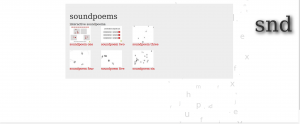
Although all of the works of kinetic and interactive poetry presented to us for this week’s discussion are interesting and engaging in their own right, the two works that stand out the most to me are Rain on the Sea and Sound Poems.
Jörg Piringer’s Sound Poems are a selection of six different poems that allow the reader to actively engage with his webpage by allowing the reader to click and/or drag letters and boxes that in turn create various sounds. As mentioned by Rettburg, sound poetry has roots in both Futurist and Dadaist movements. While engaging in Piringer’s work, the influence from these movements, especially Dada, are quite apparent. From an outside perspective, this work holds almost no similarities to the traditional poetry that most people are used to. Jörg Piringer’s Sound Poems have a quality of defiance to traditional poetry due to the work’s avante garde nature.
Rain on the Sea by Y0UNG-HAE CHANG HEAVY INDUSTRIES on the other hand deals with the genre of film poetry, as it is comprised of a poem that progresses with fast cuts from one line to the next accompanied by a cinematic backing track reminiscent of music found in early 20th century silent films. The first works of film poetry actually emerged in the early 20th century, with works such as Marcel Duchamp’s Anemic Cinema (1926) and Len Lye’s Trade Tattoo (1937), where analog techniques were used to create kinetic poetry similar to what we are seeing today (Rettburg 130). I myself am quite comfortable with the medium that is film so therefore, despite the fact that the text on the screen came and went rather quickly, enjoyed how the poem was presented to me in Rain on the Sea.